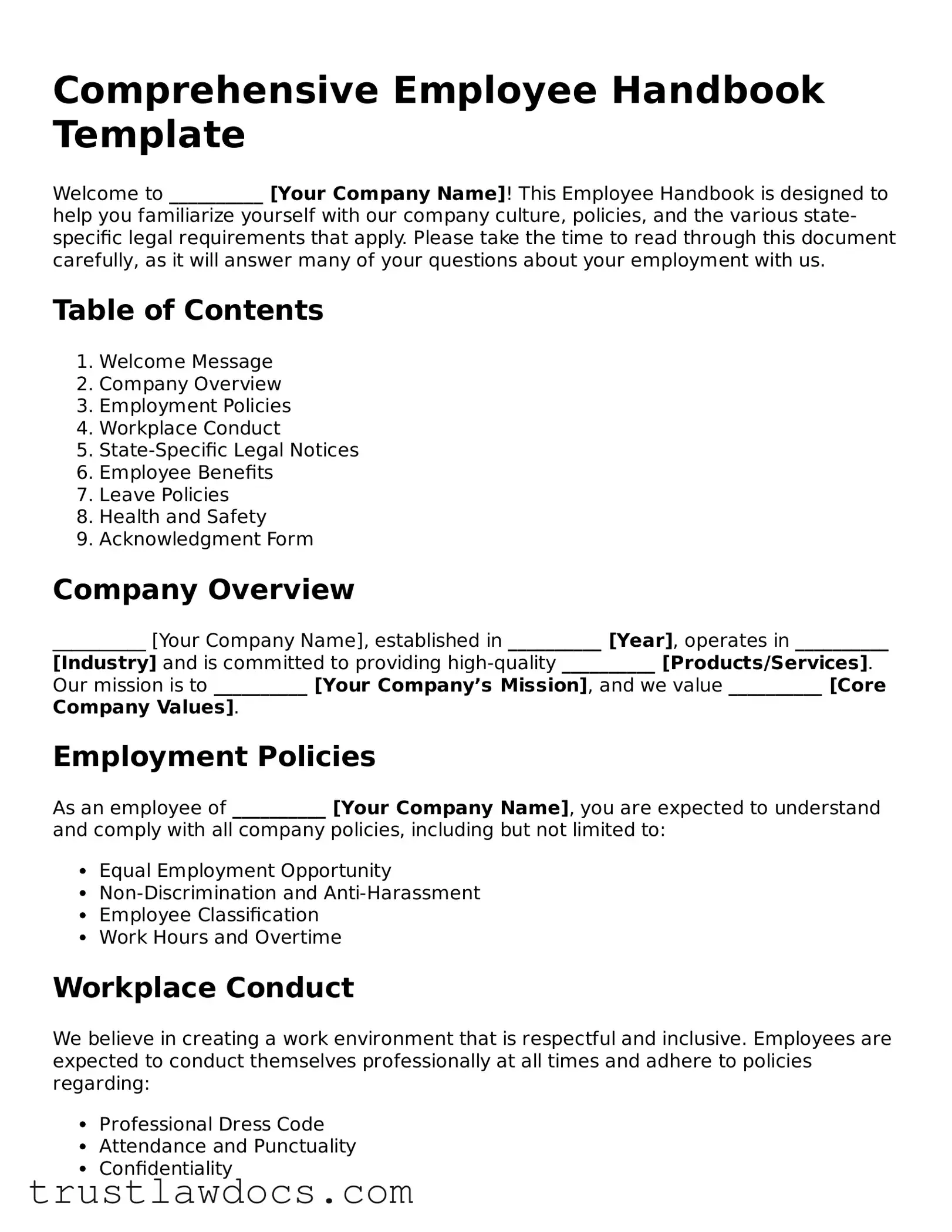The Employment Contract is akin to the Employee Handbook form in several notable ways. Both documents serve as foundational agreements between an employee and employer, setting the stage for the employment relationship. An Employment Contract, much like an Employee Handbook, outlines the expectations, roles, responsibilities, and conditions of employment. Where they differ primarily is in their specificity and legal binding; employment contracts often detail the terms related to the specific employment of one individual, including salary and duration, while handbooks provide a comprehensive overview of company policies applicable to all employees.
Company Policy Documents share a close resemblance to the Employee Handbook by providing employees with a roadmap of the company's operational principles, behavioral expectations, and procedural norms. These documents, both designed to communicate critical information, help in fostering a positive and productive work environment. While an Employee Handbook is comprehensive, covering a range of topics from conduct to benefits, Company Policy Documents might focus on specific areas like internet usage, confidentiality, or harassment policies.
The Code of Conduct is similar to an Employee Handbook as it articulates the values, ethical standards, and expectations a company has of its employees. Both documents act as benchmarks for professional behavior within the organization, ensuring that all employees operate in a manner that reflects the company's principles. The distinction often lies in the scope, with a Code of Conduct focusing more on ethical and moral guidelines, whereas an Employee Handbook encompasses a wider range of topics, including procedural and policy-related information.
Training Manuals can be paralleled with Employee Handbooks due to their shared objective of orienting and educating employees. Both documents are essential tools for acclimating new hires to the company's practices, culture, and expectations. However, Training Manuals specifically concentrate on the skills and knowledge employees need to perform their jobs effectively, offering detailed instructions and procedures, whereas Employee Handbooks are broader in scope, encompassing general employment policies and company-wide practices.
Non-Disclosure Agreements (NDAs) bear similarity to the confidentiality sections often found within Employee Handbooks. NDAs explicitly require employees to keep proprietary information confidential, a provision that is typically also included within the broader Employee Handbook. The key difference lies in the NDA's focused and legally binding nature, designed solely around the protection of confidential and sensitive information, in contrast to the Employee Handbook’s broader coverage of various employment terms and company policies.
Performance Review Forms, while primarily used for assessing an employee’s job performance, share common ground with Employee Handbooks in that they both include descriptions of expected employee performance and behavior. An Employee Handbook sets forth the standards and policies all employees are expected to adhere to, providing a basis against which performance can be measured, much like how Performance Review Forms evaluate adherence to these standards over a specific review period.
The Safety Manual, similar to the Employee Handbook, is crucial for ensuring that employees are aware of and understand the practices and procedures necessary to maintain a safe working environment. While an Employee Handbook addresses a wide range of policies and guidelines, a Safety Manual focuses specifically on health and safety procedures, emergency response protocols, and the use of protective equipment, aiming to prevent workplace accidents and injuries.
Equal Employment Opportunity Policies, which can be standalone documents or part of an Employee Handbook, outline the employer's commitment to a fair and non-discriminatory work environment. Both types of documents are integral in fostering workplace equality and compliance with federal and state anti-discrimination laws. The distinction comes with the Equal Employment Opportunity Policies’ focused aim on promoting diversity and prohibiting discrimination on various bases, such as race, gender, and age, whereas the Employee Handbook addresses a broader spectrum of employment practices and policies.
Orientations Manuals, designed to welcome and introduce new employees to the company, share similarities with Employee Handbooks in their purpose to acquaint employees with company culture, expectations, and policies. Both are pivotal during the onboarding process, helping new hires adjust and feel integrated into the company. However, Orientation Manuals often take a more general approach, supplying an overview of the company and essential information to get started, while Employee Handbooks delve into the specifics of company policies and employee responsibilities in greater detail.
